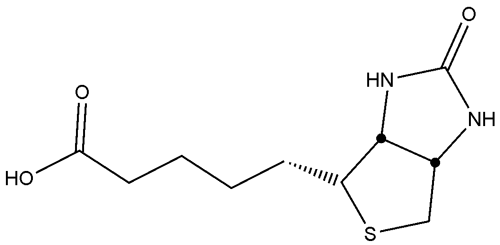
Biotin, a 244 Dalton vitamin (Vitamin H) molecule, exhibits an extraordinary binding affinity for avidin (Ka=1015M-1) and streptavidin. Biotin and avidin interaction is rapid and once the bond is established it can survive up to 3M guanidine-hydrochloride and extremes of pH.
The biotinylated molecules are efficiently probed or purified with avidin or streptavidin conjugated to reporter molecules, such as peroxidases or phosphatases, or immobilized on agarose beads.
Avidin & Streptavidin
Avidin is a glycoprotein with approximately 10% of its total mass coming from carbohydrates. Avidin has a molecular weight of 67kDa and contains four identical 128 amino acid subunits that each have a single biotin binding domain. Avidin is a basic protein with an isoelectric pH of 10-10.5 and is readily soluble in aqueous buffers containing a wide range of salt, pH, temperature and other laboratory agents. This wide range of tolerance makes avidin suitable for a wide variety of analytical applications. Streptavidin is a tetrameric protein and in many respects is similar to avidin except that it has no carbohydrate and has a slightly lower molecular weight of about 60kDa. The solubility of streptavidin (isoelectric pH5) in aqueous buffer is much lower than avidin, but the binding of streptavidin to biotin is similar to that of avidin.
An alternative to the above is monomeric avidin offers a distinct advantage over native avidin, a tetrameric molecule, and streptavidin as it has a much lower biotin binding affinity, Kd=10-7 as opposed to Kd=10-15 for native avidin. This lower binding affinity allows elution of molecules with mild elution buffers (2mM D-Biotin in 1X PBS), as opposed to the strong denaturing buffers used with native avidin.
Coupling Factors To Consider
Spacer Arms
The biotin-binding domain in avidin/ streptavidin molecules are buried 9Å below the surface and hence, the presence of bulky groups in the vicinity of the biotin-binding site may create steric hindrances and reduce the binding efficiency and the sensitivity of detection methods. Greater binding capacity can be realized by using biotin derivatives that have large spacer arms. Extended spacer arms afford the ability to overcome steric hindrances and bind deep within the binding sites of the avidin/ streptavidin molecules.
Solubility
Solubility of biotin reagents varies greatly, with some being only soluble in organic solvents, i.e. DMSO and DMF.
Membrane Permeability
This has become of great interest in studies of cell surface proteins and therefore membrane trafficking and cell signaling. The biotin reagents that are not membrane permeable are excellent candidates for labeling membrane surface proteins.
Reversibility
Biotin tags are often used for protein purification, however with the biotin:(strept)avidin binding affinity being one of the strongest known it is often difficult to release the protein from the avidin. In fact, 8M guanidine at pH1.5 is often used, which has severe detrimental effects on the protein of interest. Several biotin reagents have disulfide bonds that can be reduced to release the protein of interest under mild conditions and other biotin reagents can be removed from the protein with changes in pH.
Reactive Groups
The reagents offered have numerous reactive groups that can couple to amines, sulfhydryls, carboxyls and carbohydrates. Conjugation of biotin reagents to proteins and other molecules generally does not have adverse effects on the biological properties of the target molecules, unless biotin reagents are conjugating to or modifying active residues or sites of the protein. Due to this, it is important to find an appropriate biotin reagent and optimal biotin conjugation efficiency for maintaining the functional properties of the target molecules.
The conjugation efficiency of the reactions is dependent on the reaction groups and the buffers used for the reactions as many coupling reactions are sensitive to pH and chemical composition. Next week's blog will highlight the key features of the coupling reactions and important buffer information.






